
Section 5. Key water developments in the countries of Central Asia
5.5. Republic of Uzbekistan

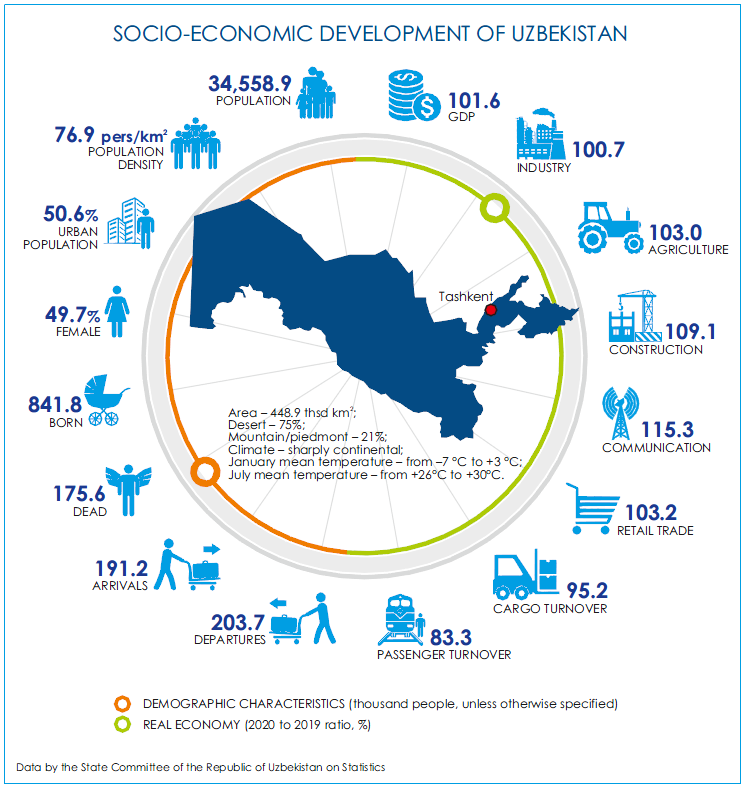
Water Sector
Water resources. Uzbekistan’s average water use is 51-53 billion m3, of which 80% (approx. 41 km3/year) is provided through transboundary river water. The estimated natural fresh and brackish groundwater deposits potentially yield 27.6 km3/year; however, they are unevenly distributed throughout the country. The demand of water users is met through a combination of surface water (50.9 km3/year), groundwater (0.5 km3/year), and the reused collector and drainage water (1.6 km3/year). The average water use by sector is as follows: 90-91% - agriculture; 4.5% - municipal sector; 1.4% - industry; 1.2% - fisheries; 0.5% - thermal power; 1% - other sectors.
Latest developments in legislation. The Concept approved by the President Decree UP-6024 on 10 July 2020 defines priority areas of water sector development in Uzbekistan, including the improvement of water accounting system, transparency of water data, modernization and automation of large infrastructure on the base of digital technology, introduction of Smart Water technology, development of synergies between education, science and production, etc. Additionally, it is planned to improve efficiency of irrigation systems from 0.63 to 0.73, reduce irrigation areas with low available water supply from 560,000 to 190,000 ha, and decrease saline irrigated area by 226,000 ha.
National strategies and programs. A State Program was approved for implementation of the Strategy of Actions in five development priority areas for 2017–2021 in the Year of Science, Education and Digital Economy Development (UP-5953 of 02.03.2020).
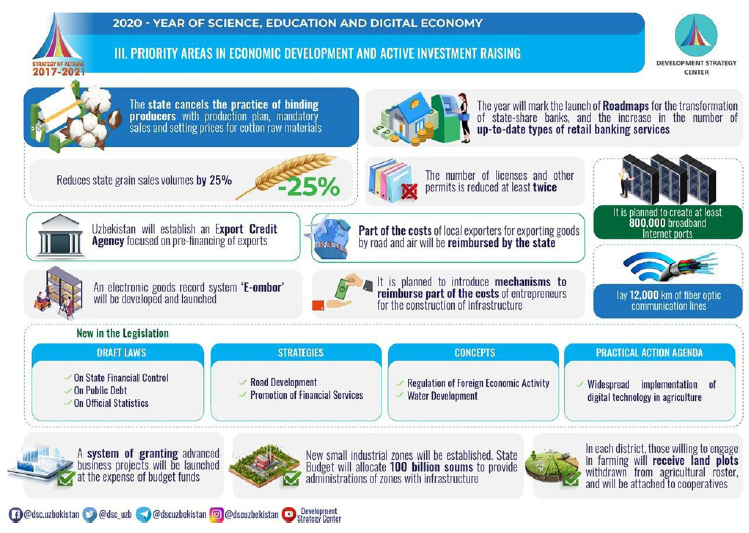
Source: strategy.uz
Implementation of initiatives of the Uzbek President voiced at XII Summit of the Heads of IFAS Founder-States. A State Program for development of the Aral Sea region in 2017-2021 was approved by President Decree in 2017. In 2020:
relevant decrees were adopted on: (1) measures for comprehensive socio-economic development of the Republic of Karakalpakstan in 2020-2023; (2) additional measures for the improvement of performance of the International Innovation Center for the Aral Region that supports an agro- and eco-touristic project titled “My garden in the Aral Sea”.
During the 75th session of the UNGA, the President of Uzbekistan initiated a special resolution about declaring the Aral Sea region an area of environmental innovation and technologies and marking the date of adoption of this important document as the International Day for the Protection and Restoration of Ecosystems (23 September).
A Committee for development of the Aral Sea region was formed at the Senate of the Supreme Council of Uzbekistan to coordinate activities, projects and programs undertaken in the region and increase control over implementation of the state policy aimed at the restoration of natural environment and the improvement of living conditions in the Uzbek territory of the Aral Sea region (October). An Advisory Committee was established in support of sustainable development in the Aral Sea region at the MPHSTF for the Aral Sea region. WHO has joined the MPHSTF. The Governments of Finland and the Republic of Korea contributed to the MPHSTF.
UNDP Uzbekistan’s Accelerator Lab in partnership with ministries and agencies launched the Green Aral Sea crowdfunding campaign. greenaralsea.org is the website, where everyone may contribute: every dollar or 10,000 soums donated will go for planting a saxaul tree (March).
SIC ICWC together with IICAR undertook the second research expedition to the exposed Aral Sea bed as part of the joint UNDP-UNESCO project “Addressing the urgent human insecurities in the Aral Sea region through promoting sustainable rural development” funded by the MPHSTF for the Aral Sea region (28 May-26 June). See Results of Expeditions on the Exposed Bed of the Aral Sea in 2019-2020.
Water management system. The total length of the main and inter-farm irrigation network is 28,940 km, the farm and on-farm networks comprise 155,000 km. More than 54,000 hydraulic structures are operated along the main and inter-farm canals; and 114,000 structures are operated on the on-farm network. More than 12,400 wells are used for abstraction of groundwater, including 4,069 wells being operated by the MWM, the other are operated by individual economic entities and population. Also, 56 water reservoirs and 13 mudfow reservoirs (debris basins) are operated in the country, and their total storage capacity is more than 20 billion m3. The total length of drainage network is 142,800 km, of which 106,100 km are open collectors (collecting drains) and 36,700 km are subsurface horizontal drains. For land reclamation purposes, the MWM also operates 172 pumping stations, 3,788 vertical drainage wells and 27,648 observation wells. For irrigation purposes, 1,687 pumping stations are operated in the country and are under responsibility of the Ministry. More than 5,285 pump units consume 8.0 billion kWh annually. Also, more than 10,280 pumping units are operated on the on-farm irrigation networks.
Water saving technologies. In 2020, water saving technologies were introduced on 133,600 ha. The total land area with water saving technologies reached 291,200 ha (about 7% of the total irrigated area). As a result, during the growing season, 280 Mm3 of water were saved and irrigation water supply of more than 300,000 ha was improved.
According to the decree on measures for promotion of water-saving technologies in agriculture (PP-4919 of 11.12.2020), the rate of introduction of drip and sprinkler irrigation systems, as well as of discrete irrigation, including laser land leveling should be increased 5 times. In 2021, water saving technologies will be introduced on 230,000 ha, and 200,000 ha will be laser leveled.
Land reclamation. As a result of repair of 13,584.1 km of collector-drainage network and 324 vertical drainage wells, 294,500 ha of irrigated land have been reclaimed. In particular, the strongly to moderately saline land area has been reduced by 29,800 ha.
The adopted decrees on urgent measures for the effective use of water resources and the reclamation of land in Jizzak and Syrdarya provinces (PP-4801 of 11.08.2020) and in the Republic of Karakalpakstan (PP-4912 of 05.12.2020) set a plan of construction and reconstruction efforts on irrigation and drainage infrastructure until 2023.
To improve water management and accounting and land reclamation, a Research Center for water problems has been established at the Cabinet of Ministers of Uzbekistan on the base of the Khorezm experimental farm.
Groundwater. GUP Uzbekhydrogeology and its 4 field offices carry out activities on groundwater exploration and assessment. In particular, it is planned to put into operation 11 wells in Chust district, Namangan province for irrigation of unused land by groundwater. Similar wells have been drilled in Dzhizak (12), Bukhara (11) provinces, etc. The monitoring is maintained to prevent illegal use of groundwater and illegal drilling of water wells.
Projects. An agreement was signed between the Uzbek Government in the face of MWM and the Swiss Government in the face of SDC on the National Water Resources Management Project in Uzbekistan, Phase II (2020-2024) aimed to improve living conditions of the rural population through IWRM (16 June).
The Raising Awareness and Partnership for Sustainable Water and Environment Development in Uzbekistan Project (UzWaterAware) (has been completed (November 2016-2020, EU, €2.2 million). On 28 and 30 October 2020, final and reporting event of the Project took place in Tashkent. Nine active water-environmental NGOs of the country were involved in the joint implementation of activities, close cooperation was established with the Ministry of Water Management, the State Committee of Ecology and their press services, 100 events of different formats were held, and different knowledge products were developed.
The following projects were continued: (1) “South Karakalpakstan Water Resources Management Improvement Project” (2014-2022, $376.7 million, including $214.9 million of WB loan); (2) “Fergana Valley Water Resources Management Project”, Phase II (2017-2024, $225 million, including $144.9 million – WB loan); (3) Amu Bukhara Irrigation System Rehabilitation (2014-2020, $406.29 million, including $216.75 million – ADB loan, $108.97 million - JACA loan); (4) a feasibility study for the “Preparing the Climate Adaptive Water Resources Management in the Aral Sea Basin Project” (since August 2019, ADB, $1.35 million) and others.
See United Nations Development Program on implementation of “Sustainable Management of Water Resources in Rural Areas in Uzbekistan: Component 2 on Technical Capacity Building” (2016-2020) and other projects related to land resources, ecosystems, climate change and activities on the Aral Sea.
Drinking Water Supply
In the regions of Uzbekistan, 26,900 km (38%) out of 70,400 km of drinking water supply network and 1,700 km (22%) out of 7,600 km sewerage network need repair. 3,500 (38%) out of 9,300 drinking water supply facilities must be reconstructed. Centralized drinking water supply reaches 85% of the population in Fergana province, 75% in Tashkent province, 61.9% in Khorezm province and 54.2% in Kashkadarya province.
Latest developments in legislation. By the Decree "On measures for the development of social and industrial infrastructure of the Republic of Uzbekistan in 2020-2022" (PP-4565 of 10.01.2020) the Target Program for construction and reconstruction of drinking water supply and sewerage facilities in 2020 was approved. As part of the Program, the Fund for Development of Water Supply and Sewerage Systems allocated 1,277 billion soum for the construction and reconstruction of 120 water supply facilities, as well as for the construction of 3,400 km of drinking water and sewerage networks at 216 sites.
In order to solve the problem of water supply for rural settlements, by a decree of 25.09.2020 the MHCS will give annual social orders to NGOs and other community organizations for provision of drinking water for rural settlements with the population of not less than 15,000 people that have no access to centralized water supply.
International cooperation and investment projects. The Tashkent Province Water Supply Development Project is continued jointly with ADB (2017-2021, $143.8 million). 265,000 people in 58 villages in Kibray, Zangiata and Tashkent districts will get the improved drinking water supply.
In 2020, a number of agreements and memorandums of cooperation were signed between the Uzbek water supply agency (AO Uzsuvtaminot) and the Singapore Alpha Global Capital (s) Pte Ltd company, for installation of a wastewater treatment and water production system, with the Avelar Solar Technology, the OOO “Ecolos-Proyektstroy”, the Korean Ministry of Ecology and Environment and others.
The efforts have been made to ensure continuous supply of drinking water to population in provinces, including installation of solar panels, modernization and improvement of old water facilities, and application of bio-purification methods at aeration stations.
Agriculture
The total agricultural land area is 20,236,300 ha, of which: cropland – 3,988,500 ha; perennial plantation area – 383,100 ha; fallow land – 76,000 ha; hayfields and pastures – 11,028,300 ha; and other land area – 4,760,400 ha.
Latest developments in legislation. For the implementation of the Agricultural Development Strategy of the Republic of Uzbekistan for 2020-2030 a number of decrees were adopted, such as: (1) “On measures for fulfillment of Strategy tasks in 2020” (PP-4575 of 28.01.2020); (2) “On measures for wider application of market principles in cotton growing” (PP-4633 of 06.03.2020) and in grain production (PP-4634 of 06.03.2020); (3) “On measures for further improvement of agriculture and food production governance system” (PP-4643 of 18.03.2020). These decrees canceled the so-called state orders for cotton and grain. Grain produced by farmers and other enterprises will be sold through exchange auctions or direct contracts at free prices. The practices setting purchasing prices for raw cotton have been abolished.
By the decree on measures for radical improvement of land inventory (UP-6061 of 07.09.20), the Ministry of Agriculture has got powers to monitor agricultural land and crops, cropping patterns, deliver state control over protection of agricultural land, make assessment of soil quality, etc.
Subleasing of agricultural land was legalized on 29 September.
Support of farm enterprises, dehkan farms and garden plots’ owners. The analysis of January-December 2020 showed that dehkan (subsistence) farms produced 68% of the total agricultural produce, farm enterprises – 27.8%, other agricultural enterprises – 4.2%.
In order to develop and support farms, a number of decrees were adopted in 2020. Those provided for: allocation of the land put outside of production and the land comprising groundwater stock on easy terms for putting back such land into agricultural production (PP-4700 of 01.05.2020); subsidies for irrigation equipment, seeds and seedlings, and greenhouses (PP-4716 of 18.05.2020); zero customs duties for agricultural equipment bought for subsistence farms until 1 January 2022 (PP-4767 of 30.06.2020); subsidies to cover partially drilling of vertical wells, purchase of facilities for pumping water from rivers and canals for irrigation of subsistence plots and non-agricultural land in the regions suffering from water shortage (PKM 459 of 30.07.2020); allocation of 200 billion soums in support of farm enterprises and dehkan farms (PP-4964 of 27.01.2021).
Agroclusters. Uzbekistan is applying a cluster-based form of production that would cover the full chain of agrobusiness – from growing to selling of agricultural produce. There is ongoing work on the establishment and development of grain-growing, potato-growing and intensive horticultural clusters . 96 cotton-textile clusters on 907,783 ha have been established. A cotton-textile cluster association has been established in line with Decree No. 397 of 22 June to counteract systemic problems that clusters face, regulate relations between farms and clusters, etc.
For upscaling water-conservation technologies a new order of state support to agricultural producers who applied water-conservation technologies has been set (PP-4919 of 11.12.2020).
Adoption of smart agriculture and innovation technologies. The Strategy of innovative agrarian education development until 2030 (approved on 15 December) provides for modernization of the agrarian sector, improvement of education in this area, introduction of resource-saving smart agriculture and information technologies, and better integration of education, science and production. A Center of Agro-Industry Digitization has been established to maintain “Digital Agriculture” information system.
The first innovation Center of Agro-services will be opened in Fergana province to serve more than 500 farming entities on the PPP base. An innovation project is ongoing in Andizhan province on agricultural land management through satellite data. Provincial districts have been digitized and inputted into the Monterra platform. Now the land owners can get recommendations on their land management.
Projects and programs. Uzbekistan and WB signed an Agreement on financing the Agriculture Modernization Project in Uzbekistan (2020–2026, $659.3 million) aimed to digitize the agricultural sector and transfer to more efficient land and water use.
The Project for Horticulture Value Chain Promotion (2020–2025, $337.6 million, of which $213.2 million – JICA loan, $58.9 million – Uzbekistan’s contribution, $65.5 million – contribution from participants) was started. The project is designed to provide financing via commercial banks to horticultural entrepreneurs in the form of soft loans.
See Food and Agriculture Organization on implementation of FAO-GEF projects, such as: (1) Integrated natural resources management in drought-phone and salt-affected agricultural production landscapes in Central Asia and Turkey (CACILM-2); (2) Smart farming for the next generation; (3) Shifting food systems and land use to a sustainable track and supporting land restoration
The “Agricultural diversification and modernization” Project is continued in Andizhan, Namangan and Fergana provinces (2018-2023, with the involvement of IFAD). A loan agreement was signed for financing the project phase 2 (04.08.2020) aimed to increase incomes of more than 375,000 people in the region through the introduction of modern farming methods and creation of additional high-paid jobs.
International cooperation. The Global Agro-Industrial Forum of Uzbekistan was held as part of the International Agricultural Exhibition on 11-12 March. The agricultural ministers of the CA countries met at a videoconference on 19 May. A video-meeting was organized with the European Commissioner for Agriculture and Rural Development on 8 December. The Ministry of Agriculture signed a framework cooperation agreement with the French company “Rungis Semmaris” on 9 December.
Energy
The available generating capacities in Uzbekistan amount to 12,900 MW, of which 11,000 MW (84.7%) – TPP; 1,850 MW - HPP (14.3%); and, more than 133 MW (1%) – isolated stations. The main source of energy generation is 11 thermal plants, including 3 cogeneration plants. The capacity of modern energy-efficient blocks is 2,825 MW (25.6% of the total capacity of TPP).
The hydropower sector includes 42 HPPs, including 12 large ones, with the total capacity of 1,680 MW (90.8% of the overall HPP capacity), 28 small HPPs of 250 MW in total (13.5%) and 2 micro plants of 0.5 MW. 30 HPPs with the total capacity of 532 MW (4 large plants – 317 MW and 26 small plants – 215 MW) are located along watercourses. 10 HPPs are a part of reservoir systems and have the total generating capacity of 1,400 MW. The hydropower use coefficient is 27% in Uzbekistan.
In 2020, 66.4 billion kWh of electric energy were produced in Uzbekistan. TPP generated 60.7 billion kWh (56.4 billion kWh in 2019), while HPP generated 5 billion kWh (6.5 billion kWh in 2019).
Latest developments in legislation. According to the “Digital Uzbekistan – 2030” Program and the Decree “On the state program for implementation of the Strategy of Actions in five development priority areas in 2017–2021 in the Year of Science, Education and Digital Economy Development”, the supervisory control and data acquisition (SCADA) and the energy consumption management (EMS) systems are introduced in the energy sector.
The Law on amending and supplementing the law on rational energy use (628 of 14.07.2020) sets the order of state control over energy efficiency aimed to limit production and import of produce, which is not energy efficient, and promote energy saving by public agencies and institutions. The Ministry of Energy was appointed responsible for promotion of rational water use.
Provisions on the Extrabudgetary intersectoral fund for energy saving were adopted (PKM-640 of 9.10.2020) to mobilize investments and financing for energy efficiency projects in economic sectors, social sector, and dwellings.
National strategies and programs. The Government approved the Concept on provision of the Republic of Uzbekistan with electric energy for 2020-2030. The Concept envisages modernization and reconstruction of power stations, construction of new stations on the base of energy efficient technologies, improvement of energy accounting system, development of RES, etc. In particular, by 2030 it is planned: (1) to raise capacities from 12.9 to 29.3 GW and increase power production from 63.6 to 120.8 kWh; (2) to reduce the use of natural gas from 16.5 to 12.1 billion m3; (3) to decrease transmission losses to 2.35% and distribution losses to 6.5% (1.85 times lower than in 2019).
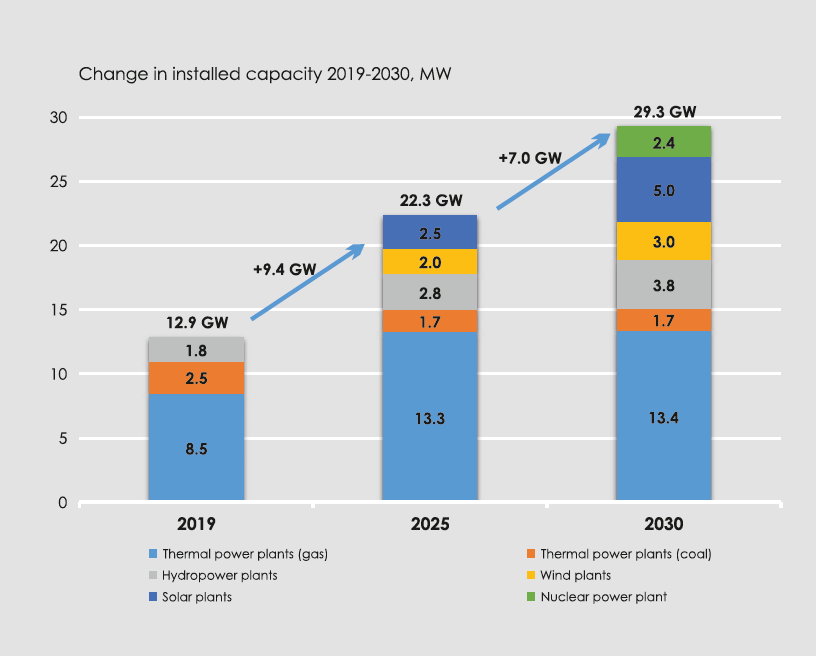
Source: Concept on provision of the Republic of Uzbekistan with electric energy for 2020-2030
A national Low-Carbon Energy Strategy is developed on the basis of the Concept and with assistance from the EBRD. By 2030, it is planned to deploy up to 3 GW of wind energy, 5 GW of solar energy, and 2.4 GW of nuclear energy.
Hydropower. The Ministry of Energy informed on the beginning of construction of a small hydropower at Sardoba reservoir (2020-2022, €21.3 million, installed capacity – 10.7 MW) in line with the relevant decree of 29 January 2020. The dam of Sardoba reservoir collapsed on 1 May. See Sardoba Dam Collapse.
In 2020, modernization of the following plants was completed : (1) 15 MW HPP-14 on the Bozsu Canal; (2) 7.05 MW HPP-2 of South-Fergana Canal in the cascade of Shakhrikhan HPPs; (3) 15.34 MW Kadar’I HPP-3 as part of Chirchik-Bozsu water-energy conveyance system.
Regional and international cooperation. Negotiations between Uzbekistan and Tajikistan are underway on joint construction of two HPPs of the total capacity at 320 MW on the Zarafshan River (see Bilateral Water Cooperation, Key Water Developments – Tajikistan).
The Russian company “Siloviye mashiny”, which opened its representative office in Tashkent, works on: (1) construction of small hydropower on the Dargom (two hydroaggregates 3.2 MW each) and the Bogishamol canals (three hydroaggregates 2.15 MW each); (2) modernization of Farkhad HPP (127 MW) and Tupalang HPP (175 MW). It was planned to deliver equipment for Lower Chatkal and Pskem HPPs and small HPP at Sardoba reservoir.
The French Development Agency signed an agreement with the Ministry of Finance for provision of a €55.8 million loan, of which €46.5 million would go to construction of Paitak small HPP in Andizhan province, small hydropower on the South-Fergana Canal and €9.3 million – for safety of Charvak HPP.
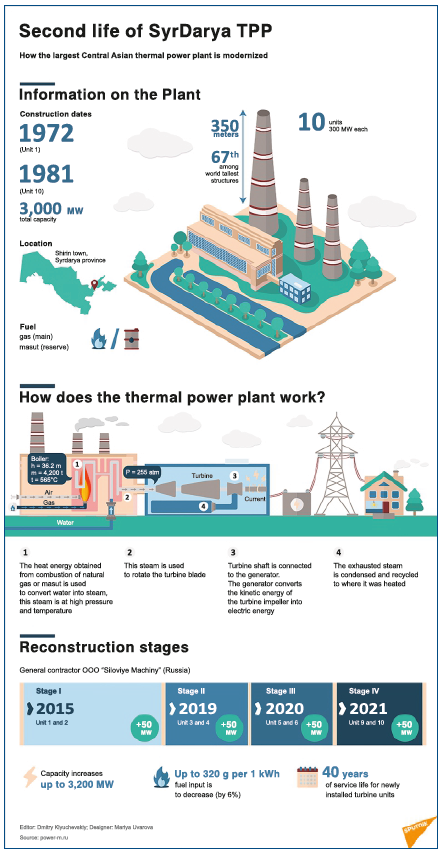
Source: Sputnik
Thermal energy. In line with the above mentioned concept, the efforts are undertaken under the following projects: (1) construction of third 650 MW unit at Navoyi TPP , construction of new TPP in Syrdarya province ; (2) modernization of Talimarjan TPP; (3) modernization of Syrdarya and Takhiatash TPPs; (4) reconstruction of Fergana TPP.
International cooperation. Investment agreements were signed for construction of TPPs in Tashkent province by Turkish companies: (1) «Cengiz Enerji», 240 MW; (2) «Aksa Enerji Uretim A. S», 240 MW.
Atomic energy. The UzAtom Agency jointly with Russian experts continues surveying the site selected for construction of a nuclear station in Jizzak province.
As part of cooperation with IAEA, negotiations were held with IAEA delegation on 12 October and pre-INIR online mission was undertaken to discuss a self-evaluation report submitted by Uzbekistan (9-12 November). The INIR mission is planned for the first half of 2021.
As decided, Uzbekistan will re-join the Joint Institute for Nuclear Research as a full member since 1 January 2021.
The UzAtom’s delegation paid a working visit to India to study the country’s experience in construction and operation of nuclear stations and hold negotiations with relevant agencies on establishing cooperation in peaceful use of atomic energy (16-19 February). A Memorandum of Cooperation was signed between the UzAtom and the Global Center for Nuclear Energy Partnership at the Atomic Energy Department of India for education and training of experts in this field (21 September).
Alternative energy
Solar energy. As part of the Scaling Solar Program, with the support of International Financial Corporation: (1) financing was approved for construction of 100 MW SPP in Navoyi province ; (2) a construction tender was announced for two SPPs 200 MW each in Samarkand and Jizzak provinces; (3) construction of photovoltaic stations Sherabad I was started in Surkhandarya province; (4) preparatory work was started on photovoltaic stations in Bukhara (250 MW), Namangan (150 MW) and Khorezm (100 MW) provinces; (4) an agreement was signed with the French “Total Eren SA” for construction of 100 MW SPP in Samarkand province (13 May).
Wind energy. An Investment Agreement was signed with “Masdar” (UAE) for the project on design, financing, construction and operation of 500 MW wind power plant in Navoyi province (10 June). Another agreement was signed with ACWA Power (Saudi Arabia) for the construction of wind power plants with the total capacity of 1000 MW in Bukhara and Navoyi provinces.
Capacity building. Representatives of the Ministry of Energy took part in: (1) the opening ceremony of the international course “Future leaders” (25 May, course duration – from May till December); (2) training in regulation in the energy sector (9-13 November); (3) webinar “Expansion of RES and their integration in energy infrastructure: legal and technical aspects”, with the focus on German experience (23 November).
Events. The following events were held in 2020: (1) International Conference CONMECHYDRO-2020 (23-25 April); (2) roundtable with participation of a number of international financing institutions to discuss steps in reformation of the energy sector in Uzbekistan (23 October); (3) 16th meeting of the Taskforce on regional energy cooperation in Central and South Asia (2 November); (4) second Festival of Science and Atom organized by the Information Atomic Technology Center in Tashkent with the support of the UzAtom and RosAtom Corporation (27-28 November).
Environment and Climate Change
Latest developments in legislation. By the Decree on measures for further improvement of the hydrometeorological service in Uzbekistan (PP-4896 of 17.11.2020) the following documents were approved: (1) the Concept of hydrometeorological service development in Uzbekistan for 2020-2025; (2) a Roadmap for implementation of the Concept; (3) the Program for extension and automation of the observation network of the Hydrometeorological Service (UzHydromet). UzHydromet is assigned responsible state body in the field of hydrometeorology, monitoring of climate change and environmental pollution. It also functions as the Regional specialized meteorological center of WMO and the Regional telecommunication center for collection, processing and dissemination of hydrometeorological information of the WMO World weather service for the CA states. It is envisaged to establish the Center of information technology development in hydrometeorology on the base of the UzHydromet’s Information-Technological Department “Meteoinfosystem”.
A decision has been made to establish the Southern Ustyurt National Nature Park on the total area of 1,447,143 ha and the Kitab Geological National Nature Park.
The following regulatory documents were approved also in 2020: General technical regulations on environmental security; Concept of forestry development in Uzbekistan until 2030; Decree on further improvement of the mechanism of environmental impact assessment; Decree on additional measures on afforestation in Republican regions and the Aral Sea region.
Projects. As part of a GEF/UNEP/UzHydromet project, UzHydromet prepares the Fourth national communication and the First biennial update report of the Republic of Uzbekistan for UNFCCC. The systemic and effective work is done in line with the Montreal Protocol within the framework of the Project “Complete HCFC Phase-out in Uzbekistan through promotion of zero ODS, low GWP and energy efficient technologies” (Goscomecology/UNDP/GEF) . The project results were presented at the third Steering Committee meeting on 4 December. Representatives of Goscomecology and the State Customs Committee have become nominees of the Montreal Protocol Award for Europe and Central Asia for 2019-2020. As part of the UNDP/GEF/Goscomecology Project “Sustainable natural resource and forest management in key mountainous areas important for globally significant biodiversity”, a Biodiversity Conservation Information Management System (BCIMS) was developed. BCIMS is a restricted platform. The website has been developed for open access.
Events. A number of online events were held: (1) an expert discussion on environmental problems related to water, air and urban development in Uzbekistan under the aegis of IWPR and CABAR (18 April); (2) first Central Asian Conference on climate journalism. During the conference, journalists, bloggers, researchers and experts from Kazakhstan, Tajikistan, Uzbekistan and Kyrgyzstan presented joint project results and held seminars on climate data handling, climate change disinformation, climatic activism and journalism (26-27 November); (3) eco-challenge #BeTheWave for youth to share their vision on climate change (1-7 December, EU Delegation in Instagram).
The Uzbek delegation took part in (1) High-level Conference “Green Central Asia” as part of implementation of the new EU strategy for CA and Afghanistan (28 January, Berlin); (2) 9th meeting of EU-CA working group on environment and climate change (12-13 February, Brussels, Belgium) and the 1st Meeting of EU-CA WGECC Coordination Committee (15 June); (3) third Central Asia Conference on climate change/ CACCC -2020 (23 October).
SDG in Uzbekistan
The group of UN organizations in Uzbekistan together with the Senate of Oliy Majlis of the Republic of Uzbekistan and the National Movement “Yuksalish” have launched the initiative “Decade of Action to achieve the Sustainable Development Goals in Uzbekistan by 2030” (2 March). A meeting of the Parliament’s Commission for control over implementation of the national Sustainable Development Goals in Uzbekistan was held on 13 May to discuss the draft Voluntary National Review (VNR).
Uzbekistan presented its first VNR at the UN High-Level Political Forum on Sustainable Development on 15 July. The implementation of SDGs in Uzbekistan concurred with ambitious reforms under the Strategy of Actions in five development priority areas of Uzbekistan. There are ongoing efforts to integrate national SDGs into Republican, sectoral and regional development strategies and programs, including the developed Concept of comprehensive socio-economic development in Uzbekistan and the Strategy of poverty reduction by 2030. According to the Sustainable Development Report 2019, Uzbekistan was on the 52nd position among 162 countries . The strategic goals and tasks before Uzbekistan are set as follows: (1) further reduction of poverty and inequality; (2) improving quality and access to social services, particularly health care and education, with the focus on remote regions and vulnerable groups; (3) ensuring sustainable employment, especially among youth and women; (4) more rational use of water, energy and land resources for sustainable development and adaptation; (5) ensuring rule of law, freedom of speech and press, transparency and quality of public services, fighting against corruption.
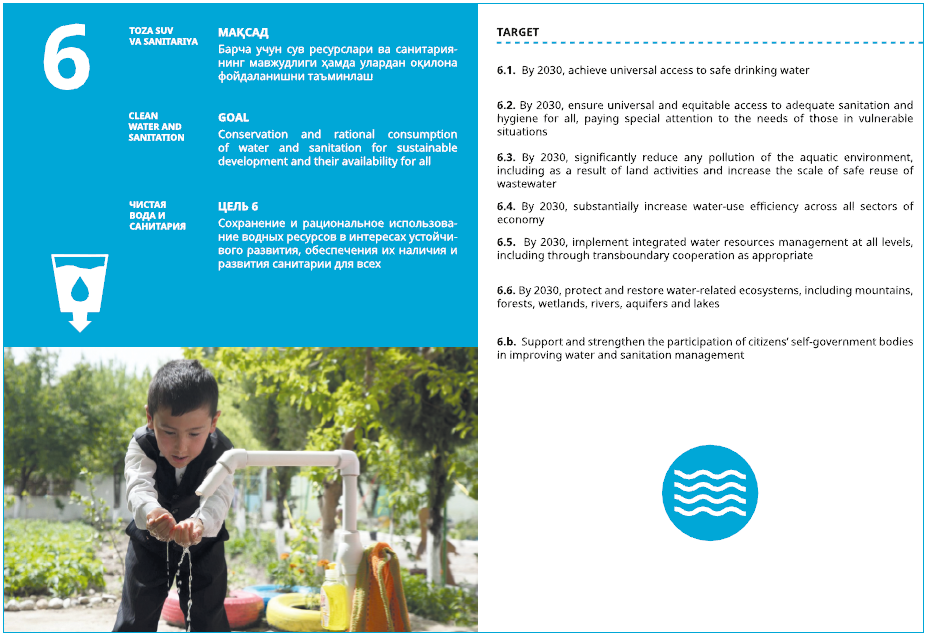
Source: “National sustainable development goals and tasks”
UN agencies launched a new Joint Programme “The Integrated National Financing Framework for Sustainable Development in Uzbekistan” to support Uzbekistan’s financing of the Sustainable Development Goals on 9 December.
Emergencies
Latest developments in legislation. The Decree "On further improvement of the state system for prevention and actions in emergency situations in the Republic of Uzbekistan" was adopted on 26 August 2020. In this context, operational territorial units for protection of population and territories from emergencies will be established at relevant state administrations and khokimiyats. These units will provide operational control, forces and facilities to eliminate emergencies and will have automatic systems for warning of the risks of emergencies and information.
Dam collapse. The dam of Sardoba reservoir collapsed in Syrdarya province on 1 May. This has resulted in flooding of settlements and destruction of roads. About 70,000 people have to be evacuated. The disaster affected the south of Kazakhstan as well. More than 30,000 people have to be evacuated there. A governmental commission and an intergovernmental Uzbek-Kazakh group were formed for recovery from the accident. See Sardoba Dam Collapse.
Preventive measures. To prevent flooding during spring rains, the Ministry of Emergency Situations and other relevant services of Jizzak province made efforts to clear channels and protect banks. Representatives of the Ministry of Emergency Situations, UzHydromet and Goskomgeologiya have made aerial surveys in the basins of the Pskem and Oygaing rivers to assess risks in case of potential breakthrough of high-mountain lakes in Tashkent province.
Foreign Policy and International Cooperation
In 2020, the President of Uzbekistan paid formal and working visits to Turkey (February), the Russian Federation (June) and Kazakhstan (September).
The country was visited by the Foreign Minister of RF (January), US State Secretary (February), Prime-Minister of Kazakhstan (February), as well as by delegations from WB (January), Hungary (January), China (February), and EBRD (March).
More than 20 high-level dialogues and over 80 meetings and interdepartmental visits were organized in the online format under the pandemic conditions. Uzbekistan sent humanitarian aid to a number of countries, including Azerbaijan, Belarus, Kyrgyzstan, Tajikistan, Afghanistan, etc.
Key developments in the foreign policy of Uzbekistan
Development of alliances and strategic partnerships. The CA region is among the priorities of the Uzbekistan’s foreign policy. In 2020, the volume of trade exceeded $3 billion with Kazakhstan, $900 million with Kyrgyzstan, $500 million with Tajikistan and was about $530 million with Turkmenistan. The CA countries prepare a five-sided interstate document on friendship, good neighborliness and cooperation for the CA development in XXI.
The meetings of Joint Demarcation Commissions with Tajikistan (7 January, Tashkent) and with Kazakhstan (18-24 February 2021, Almaty) were held for successful delimitation and demarcation of the national frontier.
Upon the initiative of the President of Uzbekistan, the International Institute for Central Asia was established in Tashkent in 2020. The Institute will serve as a platform for studying ongoing processes in the region and developing promising multilateral projects for mutually beneficial cooperation (see Science and Innovations).
“…Today, the Central Asian states face an important strategic task. This is to ensure deep integration of our region into the global economic, transport and transit corridors. In this regard, we propose to establish a Regional Centre for the Development of Transport and Communications…” (from the statement of the President Shavkat Mirziyoyev at the 75th Session of the UNGA).
Bilateral cooperation with Afghanistan is developed. During the visit of Afghan delegation to Uzbekistan, an agreement was signed between the Uzbek national energy company and the Afghan “Da Afghanistan Breshna Sherkat” (DABS) on power supplies to Afghanistan for a period of 10 years. The parties also discussed how to accelerate the construction of Surhan-Pulehumri transmission line, approved and initialed a draft agreement between the countries on international motor service (28-29 August).
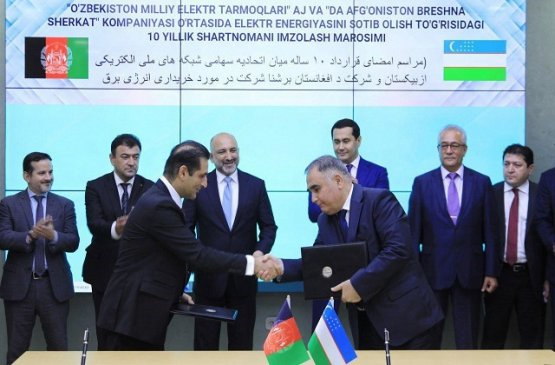
Decrees were adopted in 2020 on measures for further extension and enhancement of economic cooperation with Afghanistan (4892 of 12.11.2020) and on measures for development of specialized economic and small industrial zones in Surkhandarya province and Tashkent city (6109 of 12.11.2020) to create new legal environment for cooperation with Afghanistan.
Participation in international organizations
In 2020, Uzbekistan chaired the CIS. Under the chairmanship of Uzbekistan, over 100 multilateral events were organized, including meetings of the Council of CIS Foreign Ministers (12 May and 10 December), the Council of the CIS Heads of Government (29 May and 6 November) and the Council of the CIS Heads of State (18 December). The Permanent Representative of Uzbekistan at UN presented the resolution “Cooperation between the United Nations and the Commonwealth of Independent States” , which was unanimously adopted on 23 November. In 2020, Uzbekistan also joined several sectoral bodies of CIS, including the Council for youth affairs, Advisory Committee for labor, migration and social protection, Advisory Committee for consumer rights protection, and the CIS Interstate Council on industrial safety.
Uzbekistan got the status of observer in EAEC in 2020.
On July 7, Geneva hosted the 4th meeting of the Working Group on the accession of the Republic of Uzbekistan to the WTO via video-conferencing. The meeting resulted in agreement on bilateral negotiations on ensuring access to the market of goods and services from July 20 to July 31 2020, as well as on transition to the next stage of negotiations on accession to the WTO, namely, the preparation of an evidence summary, which is the basis for the Report of the Working Group on Uzbekistan's accession to the Organization. Uzbekistan took the two-year chairmanship of the FAO Regional Conference for Europe at its 32nd session (2-4 November).
Promotion of the national interests and reinforcement of the country’s image
The law on ratification of the Charter of the Hague Conference on private international law (605 of 02.03.2020) and the Decree on the improvement of Uzbekistan’s position in international ratings and indices (6003 of 02.06.2020) were adopted.
Also, Uzbekistan has become a member of the UNESCO Convention on the Protection and Promotion of the Diversity of Cultural Expressions.
As part of Uzbekistan-EU cooperation, (1) experts discussed preparation of the UNGA draft special resolution on the announcement of the Aral Sea region as an area of environmental innovation and technologies at the webinar “Introduction of environmental technologies and innovations in the Aral Sea region within the framework of implementation of the new EU Strategy for Central Asia: Cooperation between Uzbekistan and Belgium” (22 October); (2) negotiations were conducted on the Extended Partnership and Cooperation Agreement . Uzbekistan took part in a videoconference on “Prospects and opportunities for enhancing cooperation between the European Union and Central Asian countries. The role of Uzbekistan in implementation of the European Strategy in the region” (3 July). The European Commission has made a positive decision on the Uzbekistan’s application to get the beneficiary status in the Generalized Scheme of Preferences (GSP+).
Participation in regional and international videoconferences: “Strengthening regional and international cooperation to ensure peace, stability and sustainable development in the Central Asian region” (22 June); “The Future of Afghanistan: Perspectives from Central Asia and Iran” (9 July); “The Caspian Region in the COVID-19 Era: Implications for Security Policy and Regional Cooperation” (11 July); “China – Pakistan Economic Corridor and Central Asia: Emerging connectivity opportunities” (9 September); “Central Asia and the EU: Multilateral cooperation to achieve sustainable development of the Eurasian region” (30 September); Economic Forum “EU-Central Asia dialogue on partnership for prosperity” (7 December).
The following events were also held in 2020: “Efforts of Uzbekistan and Pakistan in resolving the situation in Afghanistan: Prospects for mutually beneficial cooperation” (12 August); online conference “Cooperation between Central and South Asia in the process of a peaceful settlement in Afghanistan” (20 August); videoconference “Policy of good neighborliness and mutually beneficial cooperation in Central Asia: Prospects for cooperation between Uzbekistan and the EU” (24 September).
Sources:
Official sites of the: President; Legislative chamber of Oliy Majlis; MFA; Ministry of Investment and Foreign Trade; Ministry of Water Management; Ministry of Energy; Goskomecologiya; Ministry of Agriculture; National law database; Institute for Strategic and Regional Studies; EC CIS; CIS Portal
Information agencies and sites: Uzdaily.uz, Norma.uz, Dunyo, Sputnik, Kun.uz